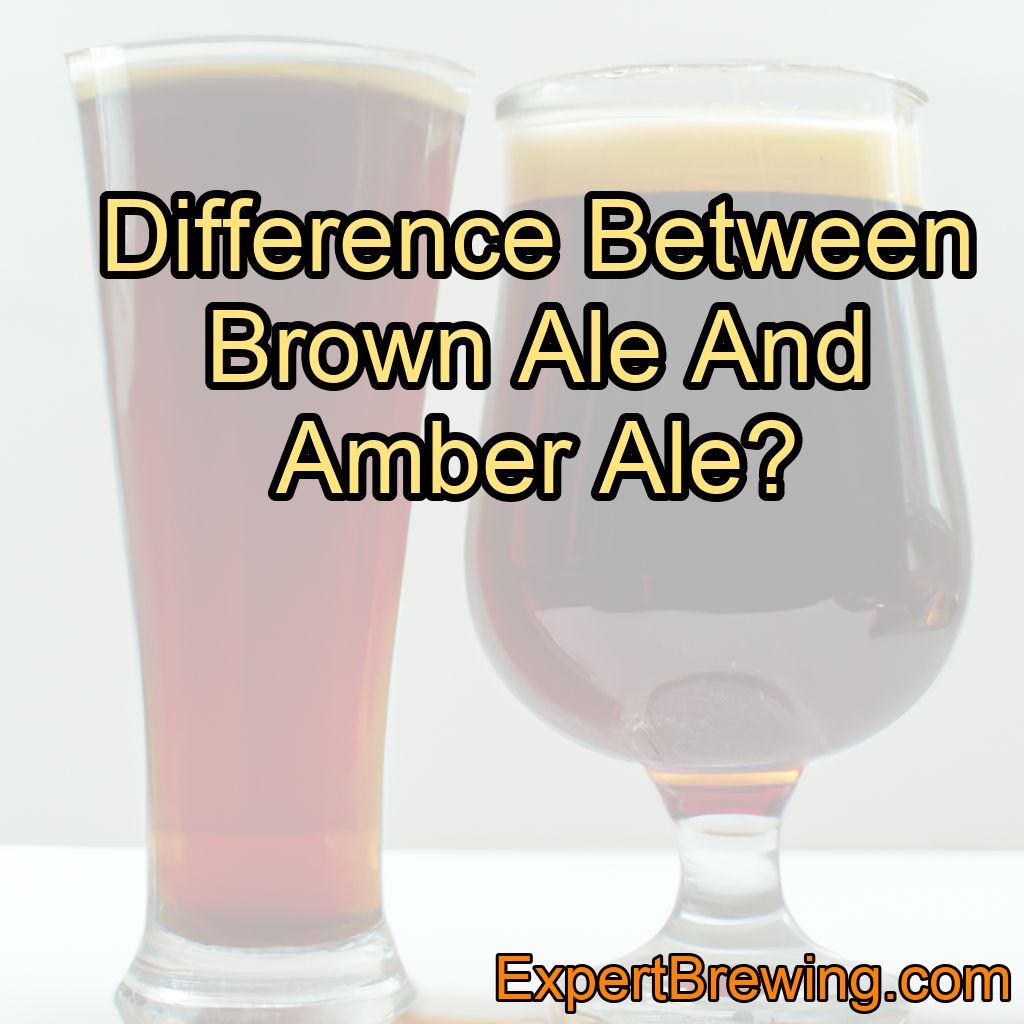As an expert brewer, one of the questions I often get is what the difference is between a brown ale and an amber ale. Both have a rich, malty character that makes them flavorful and enjoyable, but there are some key distinctions that set them apart.
In this blog post, we will explore the differences in ingredients, brewing processes, flavors, and history to shed light on the unique qualities of brown ales and amber ales. We’ll also discuss some of the best examples of each style, so you can enjoy these delicious brews for yourself!
The primary difference between brown ale and amber ale is the color and intensity of the malt flavor. Brown ales are darker in color and have a more pronounced maltiness, while amber ales are lighter in color with a more balanced malt profile.
History of Brown Ale and Amber Ale
Brown Ale
The history of brown ales dates back to England in the 17th century. At this time, brewers were making a wide variety of beers that were characterized by their color, such as pale ales, red ales, and dark ales. Brown ales evolved from these early dark ales and became popular in the industrial regions of northern England.
During the 20th century, the popularity of brown ales waned as lighter, more refreshing beers such as pilsners and pale ales became more popular. However, the craft beer movement of the late 20th and early 21st centuries has helped revive interest in brown ales, and there are now many excellent examples of the style available.
Amber Ale
Amber ales, on the other hand, have their roots in the United States. They emerged in the late 20th century as an American interpretation of the classic English pale ale. Amber ales are characterized by their amber color, which is a result of using a blend of pale and darker malts.
Amber ales quickly gained popularity in the American craft beer scene, and they remain a popular style today. Many craft breweries across the United States produce their own unique interpretations of the amber ale style.
Ingredients
Brown Ale
The key ingredients in brown ales are malt, hops, water, and yeast. The malt used in brown ales is typically a blend of pale malt and darker, more heavily roasted malts. This combination gives brown ales their characteristic color and rich, malty flavors.
In addition to the base malts, specialty malts such as crystal, chocolate, and caramel malts may be used to add complexity and depth to the beer’s flavor profile. Hops used in brown ales are typically of English origin, such as Fuggle, Golding, or Challenger. These hops provide a subtle, earthy bitterness that complements the malt flavors.
Amber Ale
Amber ales also use a blend of pale and darker malts, but the proportion of dark malts is typically less than in a brown ale. This results in a lighter color and a more balanced malt profile. The malt bill for an amber ale may include pale malt, crystal malt, and small amounts of darker malts such as Munich or Vienna malt.
Hops used in amber ales tend to be of American origin, such as Cascade, Centennial, or Chinook. These hops provide a more assertive, citrusy bitterness that contrasts with the malt flavors. Some amber ales may also include adjuncts like honey or spices to add complexity to the flavor profile.
Brewing Process
The brewing process for brown ales and amber ales is similar, with both styles typically using the traditional infusion mashing method. The key difference in the process lies in the selection and proportion of malts used, as well as the choice of hops.
Brown Ale
When brewing a brown ale, the darker malts are added to the mash tun along with the pale malt. The temperature of the mash is typically held around 152°F (67°C) for 60 to 90 minutes, allowing for the conversion of starches to fermentable sugars. The wort is then boiled, with hops added at various points during the boil to provide bitterness, flavor, and aroma.
After the boil, the wort is chilled and transferred to a fermentation vessel, where it is inoculated with yeast. Brown ales are typically fermented with an English ale yeast, which contributes fruity esters and a slightly sweet, malty character to the beer.
Amber Ale
The brewing process for amber ales is similar to that of brown ales, with the key difference being the malt bill. A smaller proportion of darker malts is used in the mash, resulting in a lighter color and more balanced malt profile.
Hops are added during the boil, with American hop varieties typically used to provide a more assertive bitterness and citrusy flavor. Amber ales are generally fermented with an American ale yeast, which imparts a clean, neutral character that allows the malt and hop flavors to shine.
Flavor Profiles
Brown Ale
Brown ales are characterized by their rich, malty flavor profile. The use of darker, more heavily roasted malts gives these beers flavors of caramel, toffee, and chocolate, often with a subtle nuttiness.
The hops used in brown ales provide a gentle, earthy bitterness that complements the malt flavors. The finish is typically smooth and moderately sweet, with a lingering maltiness.
Amber Ale
Amber ales have a more balanced malt and hop character than brown ales. The malt flavors are still present, with notes of caramel and toffee, but they are not as pronounced as in a brown ale. The hops used in amber ales provide a more assertive bitterness and bright, citrusy flavors that contrast with the maltiness.
The finish of an amber ale is generally clean and dry, with a moderate bitterness that lingers on the palate.
Food Pairings
Brown Ale
Brown ales are versatile beers that pair well with a wide variety of foods. Their rich, malty flavors make them a great match for hearty dishes like roast pork, grilled sausages, or beef stew. Brown ales also pair well with aged cheeses like cheddar or Gouda, as well as with sweeter desserts like chocolate cake or pecan pie.
Amber Ale
The balanced malt and hop character of amber ales make them an excellent choice for pairing with a range of dishes. They work particularly well with grilled meats like burgers, steak, or barbecue, as well as with spicy dishes like chili or curry. Amber ales also pair nicely with earthy cheeses like gouda or fontina, and with caramel or chocolate-based desserts.
Examples of Brown and Amber Ales
Brown Ales
Some of the best examples of brown ales include:
1. Newcastle Brown Ale (England) – The quintessential English brown ale, with smooth, malty flavors and a subtle hop bitterness.
2. Samuel Smith’s Nut Brown Ale (England) – A rich, nutty brown ale with a complex malt profile and a gentle hop bitterness.
3. Brooklyn Brown Ale (USA) – An American take on the English brown ale, with a fuller body and a more assertive hop presence.
Amber Ales
Some of the best examples of amber ales include:
1. Bell’s Amber Ale (USA) – A well-balanced amber ale with a smooth, malty backbone and a bright, citrusy hop character.
2. New Belgium Fat Tire Amber Ale (USA) – A popular amber ale with a biscuity malt flavor and a moderate hop bitterness.
3. Rogue American Amber Ale (USA) – A bold, assertive amber ale with a strong malt presence and a pronounced hop bitterness.
Conclusion
In conclusion, the primary difference between brown ale and amber ale is the color and intensity of the malt flavor. Brown ales are darker in color and have a more pronounced maltiness, while amber ales are lighter in color with a more balanced malt profile.
Here are 10 key facts about brown ales and amber ales:
1. Brown ales originated in England, while amber ales were developed in the United States.
2. The malt bill for brown ales typically includes a higher proportion of darker malts, while amber ales use a more balanced mix of pale and dark malts.
3. Brown ales have a rich, malty flavor with notes of caramel, toffee, and chocolate.
4. Amber ales have a more balanced malt and hop character, with a moderate maltiness and a more assertive hop bitterness.
5. Hops used in brown ales are typically of English origin, while amber ales often use American hop varieties.
6. Brown ales are generally fermented with an English ale yeast, while amber ales use an American ale yeast.
7. Brown ales pair well with hearty dishes, aged cheeses, and sweeter desserts.
8. Amber ales work well with grilled meats, spicy dishes, and earthy cheeses.
9. Some of the best examples of brown ales include Newcastle Brown Ale, Samuel Smith’s Nut Brown Ale, and Brooklyn Brown Ale.
10. Some of the best examples of amber ales include Bell’s Amber Ale, New Belgium Fat Tire Amber Ale, and Rogue American Amber Ale.
FAQs
Is ale an amber beer?
No, ale refers to a type of beer that is fermented at warmer temperatures using a specific type of yeast. Amber beer, on the other hand, refers to a beer that has a reddish or amber color, which can be achieved through the use of certain malts. However, some ales may have an amber color, but not all amber beers are ales.
What is considered amber beer?
Amber beer is a beer that is characterized by its amber or reddish-brown color, which is achieved through the use of darker malts. It is typically medium-bodied and has a balanced flavor profile that combines the sweetness of the malt with the bitterness of the hops. Examples of amber beers include amber ales, Vienna lagers, and Oktoberfest/Märzen beers.
Is amber ale the same as Brown Ale?
No, amber ale and brown ale are not the same. Amber ale is typically a lighter, more balanced beer with a caramel or toffee flavor, while brown ale is darker, richer, and often has a nutty or chocolatey taste.
What brands of beer is Amber beer?
Amber beer is not a specific brand of beer, but rather a style of beer that is characterized by its amber color and balanced malt and hop flavors. Some popular brands of amber beer include Fat Tire Amber Ale, Alaskan Amber, and Yuengling Traditional Lager.
Is a brown ale an amber?
No, a brown ale is a distinct beer style that is darker and has a more complex malt profile than an amber ale.
Is amber ale the same as brown ale?
No, amber ale and brown ale are not the same. While both are ales, amber ale tends to be lighter in color and has a more balanced flavor profile with a mix of malt and hops. Brown ale, on the other hand, is darker in color and has a nutty, caramel-like flavor with a lower hop presence.




